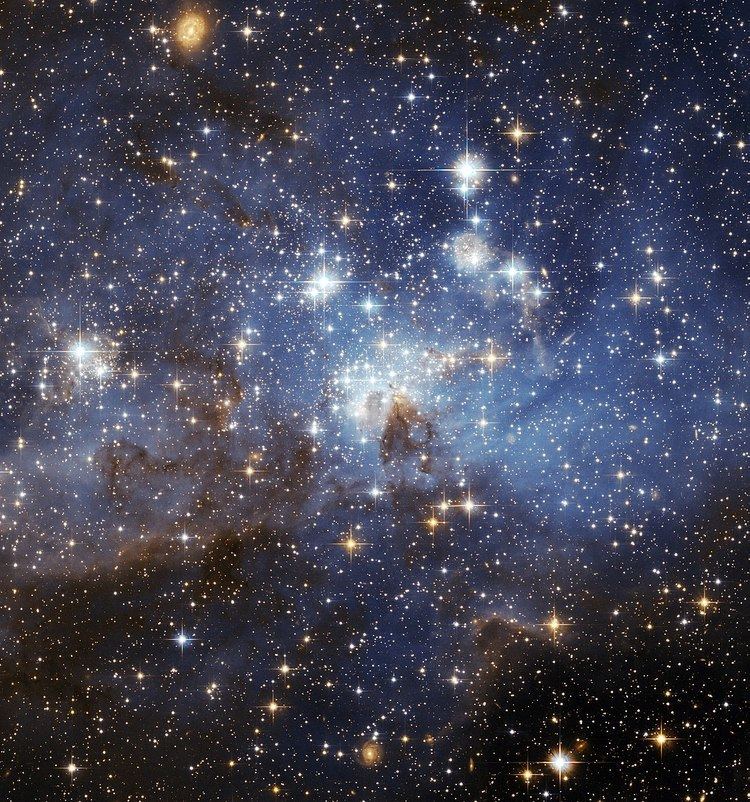 | ||
In stellar physics, the Jeans instability causes the collapse of interstellar gas clouds and subsequent star formation. It occurs when the internal gas pressure is not strong enough to prevent gravitational collapse of a region filled with matter. For stability, the cloud must be in hydrostatic equilibrium, which in case of a spherical cloud translates to:
Contents
where
Jeans mass
The Jeans mass is named after the British physicist Sir James Jeans, who considered the process of gravitational collapse within a gaseous cloud. He was able to show that, under appropriate conditions, a cloud, or part of one, would become unstable and begin to collapse when it lacked sufficient gaseous pressure support to balance the force of gravity. The cloud is stable for sufficiently small mass (at a given temperature and radius), but once this critical mass is exceeded, it will begin a process of runaway contraction until some other force can impede the collapse. He derived a formula for calculating this critical mass as a function of its density and temperature. The greater the mass of the cloud, the smaller its size, and the colder its temperature, the less stable it will be against gravitational collapse.
The approximate value of the Jeans mass may be derived through a simple physical argument. One begins with a spherical gaseous region of radius
for sound waves to cross the region and attempt to push back and re-establish the system in pressure balance. At the same time, gravity will attempt to contract the system even further, and will do so on a free-fall time,
where
The resultant Jeans length
This length scale is known as the Jeans length. All scales larger than the Jeans length are unstable to gravitational collapse, whereas smaller scales are stable. The Jeans mass
It was later pointed out by other astrophysicists that in fact, the original analysis used by Jeans was flawed, for the following reason. In his formal analysis, Jeans assumed that the collapsing region of the cloud was surrounded by an infinite, static medium. In fact, because all scales greater than the Jeans length are also unstable to collapse, any initially static medium surrounding a collapsing region will also be collapsing. As a result, the growth rate of the gravitational instability relative to the density of the collapsing background is slower than that predicted by Jeans' original analysis. This flaw has come to be known as the "Jeans swindle".
The Jeans instability likely determines when star formation occurs in molecular clouds.
An alternative, arguably even simpler, derivation can be found using energy considerations. In the interstellar cloud, two opposing forces are at work. The gas pressure, caused by the thermal movement of the atoms or molecules comprising the cloud, tries to make the cloud expand, whereas gravitation tries to make the cloud collapse. The Jeans mass is the critical mass where both forces are in equilibrium with each other. In the following derivation numerical constants (such as π) and constants of nature (such as the gravitational constant) will be ignored. They will be reintroduced in the end result.
Consider a homogenous spherical gas cloud with radius R. In order to compress this sphere to a radius R – dR, work must be done against the gas pressure. During the compression, gravitational energy is released. When this energy equal the amount of work to be done on the gas, the critical mass is attained. Let M be the mass of the cloud, T the (absolute) temperature, n the particle density, and p the gas pressure. The work to be done equals p dV. Using the ideal gas law, according to which p=nT, one arrives at the following expression for the work:
The gravitational potential energy of a sphere with mass M and radius R is, apart from constants, given by the following expression:
The amount of energy released when the sphere contracts from radius R to radius R – dR is obtained by differentiation this expression to R, so
The critical mass is attained as soon as the released gravitational energy is equal to the work done on the gas:
Next, the radius R must be expressed in terms of the particle density n and the mass M. This can be done using the relation
A little algebra leads to the following expression for the critical mass.
If during the derivation all constants are taken along, the resulting expression is
where k is Boltzmanns constant, G the gravitational constant, and m the mass of a particle comprising the gas. Assuming the cloud to consist of atomic hydrogen, the prefactor can be calculated. If we take the solar mass as the unit of mass, the result is
Jeans' length
Jeans' length is the critical radius of a cloud (typically a cloud of interstellar dust) where thermal energy, which causes the cloud to expand, is counteracted by gravity, which causes the cloud to collapse. It is named after the British astronomer Sir James Jeans, who concerned himself with the stability of spherical nebulae in the early 1900s.
The formula for Jeans length is:
where
Perhaps the easiest way to conceptualize Jeans' length is in terms of a close approximation, in which we discard the factors
It follows immediately that
Jeans' length as oscillation wavelength
The Jeans' length is the oscillation wavelength below which stable oscillations rather than gravitational collapse will occur.
where G is the gravitational constant,
It is also the distance a sound wave would travel in the collapse time.
Fragmentation
Jeans instability can also give rise to fragmentation in certain conditions. To derive the condition for fragmentation an adiabatic process is assumed in an ideal gas and also a polytropic equation of state is taken. The derivation is shown below through a dimensional analysis:
For adiabatic processes,If adiabatic index,
